Video published on November 22, 2009 on the PDN channel on YouTube.
Many centuries ago, shepherds began knotting wool into heavy woven cloth. These heavy cloths were developed into carpets that provided protection from nature's elements. Whether the first rugs were made in the near East or Siberia is not clear. However, it is clear that over the centuries, rug making evolved from a craft to a fine art form. The patterns, vibrant colors and number of knots per square inch produced beautiful handmade carpets. The early artisans showed amazing skill and ingenuity in designing, dying and producing these prized rugs. Below is a brief description of the centuries old steps used to produce handmade persian and oriental carpets:

The 6 Preliminary Steps in the Production of Handmade Rugs. Retrieved from the Bashir Persian Rugs Collection
1. Natural Fibers & Yarns Selection
Here below is a description of the type of natural fiber materials that are used to produce hand-knotted rugs rather then machine made rugs which use synthetic materials in their rugs such as polyester, nylon or olefin (polypropylene). Natural fiber rugs are much more durable than mass-produced synthetic rugs and they are made of the finest quality materials. Natural fibers area rugs not only can last for centuries but they can also protect your family and you from harmful gasses that are released into the environment over time. The natural fibers discussed below are also utilized in the production of hand-tufted and flat-woven rugs such as Kilims.
Wool
Hand-spinning wool dates back thousands of years, although when and where the technique was developed has never been determined. The process of making a wool rug begins when unprocessed wool arrives at the factory in large bales. The wool is then separated by hand to remove sticks and break up clumps. Next, the wool is fed into a machine that separates and pulls the wool into individual strands. The wool is then spun into yarn. The yarn spinning process occurs over many types of machines until the yarn becomes twisted and strong enough.
Wool is a natural material, representing a healthy choice that is environmentally friendly with a long list of benefits. The pile of wool rug is hygienic and non-allergenic, as the natural pile also deters the growth of bacteria and dust mites. It represents a great choice for asthma sufferers due to its natural filtering ability. Rugs made of wool feel soft under the foot while remaining wear-resistant and long-lasting. With proper maintenance tailored to its needs, wool rugs can last over 75 years. Homeowners benefit from an extra grip which is important for balance, good posture, and accident prevention. Moreover, wool rugs are flame resistant. Cleaning is also easier due to a protective layer that pushes dirt up and resists staining. In fact, it will trap dirt and dust until it is vacuumed. A wool rug is also a great option for adding the look and feel of luxury to any space, as wool in itself is a luxurious material.
Pure Silk
According to legend, fifteen hundred years ago in China, silk production was a state secret. The silk trade back then was so valuable that anyone who attempted to export silkworm eggs from China was sentences to death. Around 552 AD, two monks smuggled silkworm eggs to Istanbul, and silk production spread worldwide. Now that a few centuries have passed since then, it is safe to talk about how carpet manufacturers utilize silkworms to produce the finest and most luxurious silk rugs in the world. Silk has a very high tensile strength and can be twisted very finely, plus it is quite resistant. The finest silk comes from the first part of the amazingly long single thread with which silkworm spins its cocoon can strech up to 25.000 meters.
Rugs with exclusively pure silk piles are regarded as being among the most valuable of all hand-knotted rugs. They are intricately crafted: the strong silk fibers utilized in its production permit its skilled weavers to weave more knots per square inch (KPSI) than wool carpets contain. A typical Persian or Oriental rug made of wool has between 100 and 300 KPSI - a typical 100% silk rug has between 300 to 600 KPSI. As a result, weaving the rug requires 3 to 4 times the amount of work. More time is spent weaving a silk carpet than a wool carpet of a similar size. This is one of the main reasons a silk rug costs at least double the price of a wool rug. Silk pile delivers more clarity in the design patterns and adds sheen and depth. A silk rug is a great option for adding a look and feel of luxury to any space. With proper maintenance tailored to its needs, this rug can last over 100 years.
Floss Silk
Floss silk or art silk (artificial silk) as it is sometimes called is actually mercerized cotton. This type of pile (material) is woven with natural cotton warp and weft threads. It has been traditionally used in the production of certain types of rugs that are woven in the a large and industrialized city of Kayseri located in Central Anatolia which is present day Turkey.
Although floss silk is not identical to silk, a somewhat similar look is obtained by mixing cypress tree fibers with cotton that has been washed in citric acid. For this reason alone, it is important to ask the rug merchant you are buying from the type of silk contained in a rug that interests you. The type of silk utilized can either sky rocket the value of the rug or shoot it down dramatically with Floss silk representing the later.
Cotton
Cotton is another natural fiber that dyes easily and allows for rug manufacturers to produce rugs in a wide array of colors. It is used mostly for the warp threads as well as for the wefts if the rug is braided or flat woven. Since cotton is less elastic, tighter knots can be tied on cotton warps as opposed to wool. If very tight knots are tied to a wool warp, the fiber will break much more frequently that if the warps were of cotton. Consequently, woolen pile rugs with high knotting density counts will usually have cotton warps. This is very much the case for famous rug styles and designs such as the "Hereke" rug or the "Ladik" rug.
Cotton rugs are a softer alternative to jute or sisal rugs. They are fairly durable and are often machine-washable. Cotton rugs are also less expensive than wool rugs and provide buyers with a more casual look. For this reason, busy families that are on a budget or just starting a new family might find cotton rugs more interesting to purchase. Moreover, cotton material is generally considered to be a more resistant fiber then wool and it as a softer alternative to jute or sisal rugs.
2. Carding
Carding is the process in which raw wool is opened and separated. This allows each fibre to be set in a straight, or parallel position. Effective carding ensures that no fibre is intermingled with another, or with vegetable matter, sand or dirt being left in the yarn. Short fibres are separated off. The effectiveness of carding allows fibres to flow when spinning starts and facilitates a better blending for the various desired thicknesses. Many rug production companies prefer the hand carding method to maintain an originality of pure, hand-knotted carpets. Although, in recent years, there has been the introduction of some mechanical carding.
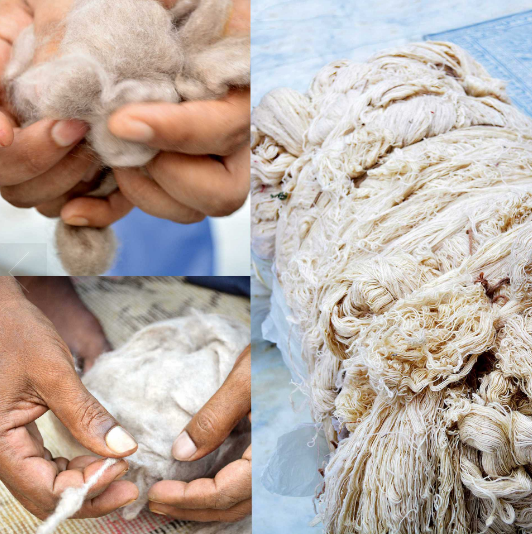
The Carding Process. Retrieved from Architectural Digest
3. Yarn Washing, Dying & Drying
Before the yarn is dyed, it is first cleaned. Wool often carries dust, grease which is removed by washing it thoroughly. Yarn is submerged into a detergent bath, and then wrung out several times before moving to the next phase of washing. The yarn is washed again in clean water to remove all remnants of detergent and it is then sun dried for two to three days.
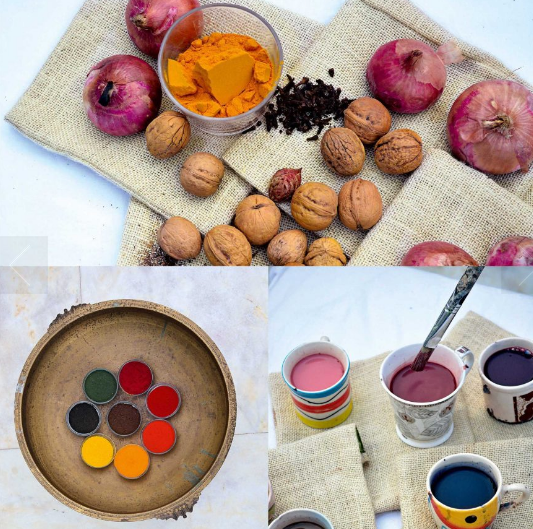
Natural Dye Sources. Retrieved from Architectural Digest
Dyes are created using a very precise combination of colors to produce the exact desired hue. Yarn is hung onto a large rack and submerged into the dye. The dye is heated to a near-boiling temperature for a predetermined amount of time. The amount of time is based on the color, the type of dye and darkness desired. Once dyed, the yarn is placed outside into the sunlight until it is completely dry. The dyed yarn is dried as soon as possible in mild sun, or in airy shadowed area to protect the newly dyed wools from being discoloured.

Dyed woolen yarn in balls. Retrieved from Architectural Digest
4. Design & Colors
The first step in the creation of any oriental rug is its inspiration or goal, in other words, its design. The basic design of the rug will dictate how much a loom is needed, what materials will be used and in what colors. Only after these decisions have been made will the actual weaving begin.
A. Designing Via Traditional Techniques
Village Rugs & Commercial Workshop Rugs
Village weaver, as well as those in the commercial workshops and factories, are usually guided by a detailed drawing of a specific design. This drawing, which is called cartoon is set down on graph paper; each square on the paper represents a single knot.
Sometimes in larger factories a number of identical rugs are produced at the same time. In this case, instead of giving each weaver a cartoon, a weaving master will recite the sequence of knots, and the weavers will follow this lead, tying knots in various colors as they’re called. Even if more than one weaver is at work on the same rug they can still follow the weaving master because the design of the rug is almost always symmetrical – one half is the mirror image of the other.

Indian man creates a wool carpet design.
Nomadic Rugs
Nomadic rugs are usually woven by women, many of whom have been trained in the craft since they were children. These weavers have usually memorized a number of traditional patterns, and their choice of design is limited to one of them. Occasionally, a nomad weaver will sketch a rough outline of a design on the vertical threads of her loom to serve as a guide, but it is just as common for him to improvise variations on a traditional basic pattern as he goes along.
B. Designing Via Software
Just like all the decorative arts, designing has been deeply influenced by the technological progress. It exists today many software which allows to the modern weaver to create digitally design in order to obtain lot of varieties of colors or pattern. Modern rug designing use more and more software to create the design of rug and to propose tailored rug for the buyer.
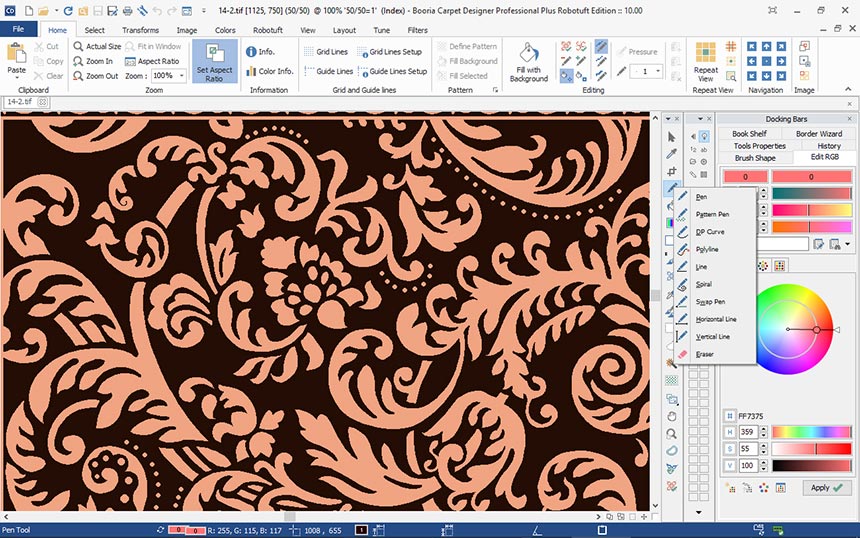
Booria Carpet Designer 10 Software. Image retrieved from the Booria CAD/CAM System.
5. Small Rug Weaving Tools
The weaving tools utilized in making a handmade rug consist of a knife, a beating, comb, and shears. These may vary a little in size and construction, and individual weavers may have several slightly different versions of each, but they are always basically the same.
The Rug Cartoon
The cartoon is a colored drawing of a rug or carpet on graph (squared) paper, which guides the weavers with both design and color. The drawing is also commonly referred to as the talim or taleem. Usually each of its squares represents a knot. The strips are coded in color and there can be as many as 200 to 800 strips or more depending on the size, motifs and colors used in one particular design. For rugs and carpets that have symmetry in design, the plate usually illustrates one quarter of the carpet that will be woven. Famous artists and designers often draw the cartoons, which are mostly used in workshops and master workshops.
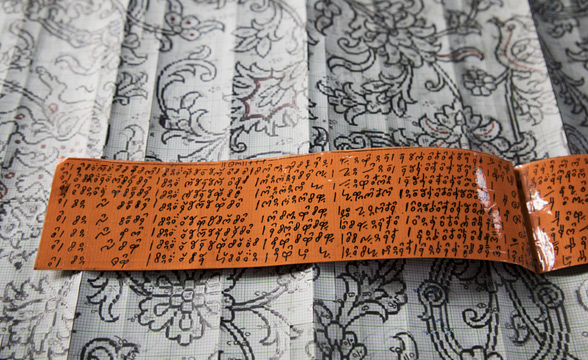
The cartoon (talim). Retrieved from Gaatha, a tale of Craft
The Rug Knife with Hook
This tool is used to cut the threads of the pile and foundation material; it usually has a hook on the end of the blade to assist in the formation of the knot. The knife is used to cut the yarn of the knot and scissors are used to cut the uneven pile after a few rows of knots have been woven. The weavers use the tip for separating the warp strands while tying a knot and then pulling out the yarn through the warp strands. The side of the hook, which works like a knife, is used for cutting the yarn after each knot is tied.
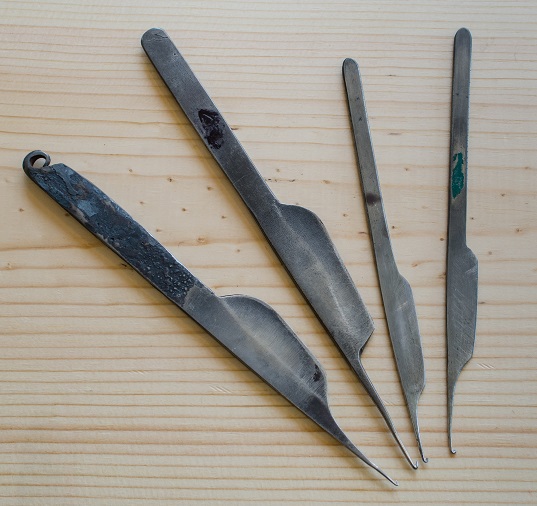
Rugs repair and restoration hook knives.
The Rug Beating Comb
This tool consists of a series of metal, bone or wood blades which are splayed to form a set of sharp teeth. It looks like a cruder version of hair combs we use. After completion of a row of knots and passing a strand of weft through the warps, the weft strand and the row of knots are beaten with a special comb. It is used to tighten the threads of the weft against the line of knots tied around the warp strings, ensuring the compactness of the rug. The comb is moved up and down through the warp strands, pressing the weft strand on top of the knots securing the knots in place.
The Shuttle
The shuttle is just a stick with notches designed into it. The weaver places the weft end of the yarn in the notched end of the shuttle and inserts the shuttle in between alternate warps to produce a weave. Not all weavers use the shuttle. Most prefer to dispense with the shuttle and pass the weft between the warps by hand which makes this an optional tool.
The Shear (Scissors)
The Shear tool is used to clip the rug's pile to an even level once the weaving has been completed. As shearing is completed section by section, the wool that is removed appears as fine dust. This dust is brushed away or swept away and discarded. The thickness of the rug is only minimally impacted by shearing, as just the finest layer necessary is removed across the surface of the whole rug.

Rugs repair and restoration hook knives.
6. Loom Preperation
The Horizontal Rug Loom
Horizontal looms are the simplest type of loom, mostly used by nomadic weavers as they are easily dismantled at the time of migration. For this reason, these type of looms are also referred to in the rug industry as "nomadic" looms. This type of loom is the most primitive version that is used in our contemporary era. These looms have not changed much since they were first utilized hundreds of years ago. These looms are well known and used by weavers especially from Turkestan and Iran.
This loom consists of four wooden beams which are laid flat on the ground and secured by pegs, stakes or nails driven into the ground. The warp strands are usually very close to the ground. As the rug is woven and the rows of knots and wefts are added, the weavers sit on the woven part of the rug in order to reach the unwoven top parts. The weaver must squat over the carpet they are making.
The fact that the loom is horizontal means that the weavers have to do much of their weaving from the sides, which becomes impossible if the rugs are too wide; consequently, rugs from this type of loom tend to be either small, or long and narrow. Having to do work from different angles makes it extremely difficult to maintain an even symmetry throughout the design, and it is therefore not surprising that nomadic rugs sometimes contain motifs of slightly varying sizes; the fact that so many are perfectly balanced and symmetrical is a glowing testament to the weavers’ skill.
This type of loom is easy to dismantle with the unfinished rug in place allowing the weavers to carry it with them when it is time to migrate which is the reason it is a very portable loom. Despite the limitations in the large sizes of rugs that it can produce, this loom is eminently suited to the nomads’ way of life, being both easy to assemble and take down, and not too large or cumbersome to be carried by donkey or camel.

Iranian man weaves in traditional way.
The Vertical Rug Loom
A vertical loom is a fixed loom and looks like a standing frame. Rugs and carpets woven on vertical looms are more exact in dimensions and design. There is no limit to the length of the carpet that can be woven on a vertical loom and there is no restriction to its width. On this rug loom the warp strands are secured to the top and bottom bars. Vertical looms are more comfortable for the weaver to operate from when compared to horizontal looms. Here the weaver sits on an adjustable seat in front of the loom. The seat is raised as the rows of knots are added. These looms are used more by city weavers and sedentary peoples because they are hard to dismantle and transport. There are three broad groups of vertical looms. Different versions of each type of loom exist however the most common ones are the Fixed "Village" Loom, the Tabriz "Bunyan" Loom and the Roller Beam Loom.

Woman working at the manufacture of carpets in Cappadocia, Turkey.
The 3 Groups of Vertical Rug Looms
Group A: The Fixed or "Village" Loom
The fixed village loom is used mainly in Iran and consists of a fixed upper beam and a moveable lower or cloth beam which slots into two sidepieces. The correct tension is created by driving wedges into the slots. The weavers work on an adjustable plank which is raised as the work progresses.
Group B: The Tabriz Loom (Bunyan Loom)
The Tabriz loom is named after the city of Tabriz located in North Western Iran. Nowadays it is mostly used in Iranian cities such as Arak, Qum, Hamadan and, as the name suggests, Tabriz. It is also used in some parts of East and West Azerbaijan province. This type of loom was developed specifically for the larger urban rug workshops as it is possible to produce with it rugs that are almost twice as long as the distance between the horizontal beams of the loom. A workshop loom may be as wide as 6 meters or 20 feet and just as high. For this reason, they are solidly constructed. The rugs that weavers produce from it are expected to last a long time
On this loom, there are two vertical posts connected by two strong cross beams, resulting in a very sturdy frame. The cross beams are adjustable so that weaving carpets in a wide range of sizes is possible. The weavers warp strands are wrapped around and behind the top and bottom bars of the loom. The warps are continuous and pass around behind the loom. Tension is obtained with wedges. The weavers here do not have to move their bodies much. On a narrow bench facing the loom the weavers sit. As the weaving continues and rug progresses, either the bench they sit on can be raised until they are almost bumping their heads on the ceiling, or the warp may be slackened so that the completed part of the rug can be wound around the bottom beam and the weavers can then work at a convenient level. This process continues until the rug is completed. When the carpets warps are severed, it is then removed from the loom.
Group C: The Roller Beam Loom
The roller beam loom is a traditional Turkish village loom. However, today it is found in most major rug workshops around the globe along with the Tabriz loom. This type of loom is generally used to produce rugs with coarser weaves. It is also used to weave very large size rugs. It consists of two movable beams to which the warps are attached. Both beams are fitted with ratchets or similar locking devices and completed work is rolled on to the lower beam. The woven part of the carpet is rolled around a lower beam. The warp strands are fed individually to the horizontal beam at the bottom of the loom which can be rotated so that the finished portions of the rug are rolled onto the beam.


 Tapis d'Orient Bashir | Bashir Persian Rugs
Tapis d'Orient Bashir | Bashir Persian Rugs
 @tapisbashir
@tapisbashir
 @bashircarpets
@bashircarpets
 @bashircarpets
@bashircarpets